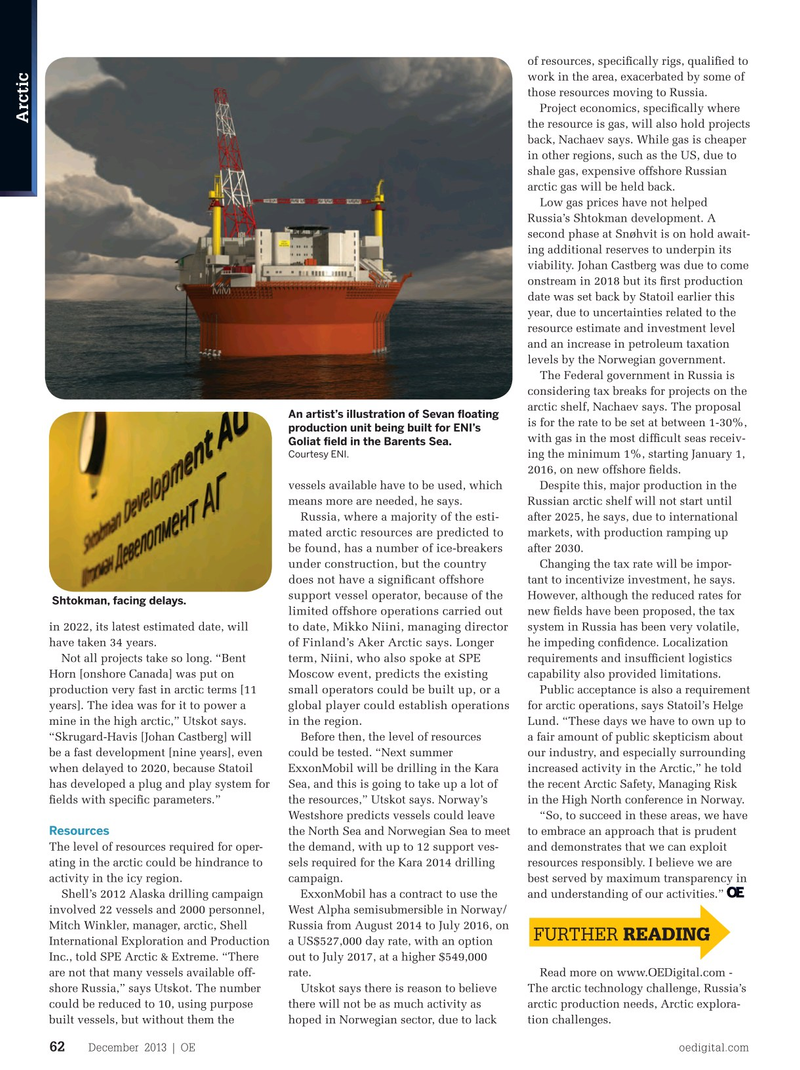
Page 60: of Offshore Engineer Magazine (Dec/Jan 2013)
Read this page in Pdf, Flash or Html5 edition of Dec/Jan 2013 Offshore Engineer Magazine
of resources, specifcally rigs, qualifed to work in the area, exacerbated by some of those resources moving to Russia.
Project economics, specifcally where
Arctic the resource is gas, will also hold projects back, Nachaev says. While gas is cheaper in other regions, such as the US, due to shale gas, expensive offshore Russian arctic gas will be held back.
Low gas prices have not helped
Russia’s Shtokman development. A second phase at Snøhvit is on hold await- ing additional reserves to underpin its viability. Johan Castberg was due to come onstream in 2018 but its frst production date was set back by Statoil earlier this year, due to uncertainties related to the resource estimate and investment level and an increase in petroleum taxation levels by the Norwegian government.
The Federal government in Russia is considering tax breaks for projects on the arctic shelf, Nachaev says. The proposal
An artist’s illustration of Sevan foating is for the rate to be set at between 1-30%, production unit being built for ENI’s with gas in the most diffcult seas receiv-
Goliat feld in the Barents Sea.
Courtesy ENI. ing the minimum 1%, starting January 1, 2016, on new offshore felds.
vessels available have to be used, which Despite this, major production in the means more are needed, he says. Russian arctic shelf will not start until
Russia, where a majority of the esti- after 2025, he says, due to international mated arctic resources are predicted to markets, with production ramping up be found, has a number of ice-breakers after 2030.
under construction, but the country
Changing the tax rate will be impor- does not have a signifcant offshore tant to incentivize investment, he says. support vessel operator, because of the
However, although the reduced rates for
Shtokman, facing delays. limited offshore operations carried out new felds have been proposed, the tax in 2022, its latest estimated date, will system in Russia has been very volatile, to date, Mikko Niini, managing director have taken 34 years. he impeding confdence. Localization of Finland’s Aker Arctic says. Longer
Not all projects take so long. “Bent requirements and insuffcient logistics term, Niini, who also spoke at SPE
Horn [onshore Canada] was put on capability also provided limitations.
Moscow event, predicts the existing production very fast in arctic terms [11 Public acceptance is also a requirement small operators could be built up, or a years]. The idea was for it to power a for arctic operations, says Statoil’s Helge global player could establish operations mine in the high arctic,” Utskot says. Lund. “These days we have to own up to in the region.
“Skrugard-Havis [Johan Castberg] will Before then, the level of resources a fair amount of public skepticism about be a fast development [nine years], even could be tested. “Next summer our industry, and especially surrounding when delayed to 2020, because Statoil ExxonMobil will be drilling in the Kara increased activity in the Arctic,” he told has developed a plug and play system for Sea, and this is going to take up a lot of the recent Arctic Safety, Managing Risk felds with specifc parameters.” the resources,” Utskot says. Norway’s in the High North conference in Norway.
Westshore predicts vessels could leave “So, to succeed in these areas, we have
Resources the North Sea and Norwegian Sea to meet to embrace an approach that is prudent
The level of resources required for oper- the demand, with up to 12 support ves- and demonstrates that we can exploit ating in the arctic could be hindrance to sels required for the Kara 2014 drilling resources responsibly. I believe we are activity in the icy region. campaign. best served by maximum transparency in
Shell’s 2012 Alaska drilling campaign ExxonMobil has a contract to use the and understanding of our activities.” involved 22 vessels and 2000 personnel, West Alpha semisubmersible in Norway/
Mitch Winkler, manager, arctic, Shell Russia from August 2014 to July 2016, on
FURTHER READING
International Exploration and Production a US$527,000 day rate, with an option
Inc., told SPE Arctic & Extreme. “There out to July 2017, at a higher $549,000 are not that many vessels available off- rate. Read more on www.OEDigital.com - shore Russia,” says Utskot. The number Utskot says there is reason to believe The arctic technology challenge, Russia’s could be reduced to 10, using purpose there will not be as much activity as arctic production needs, Arctic explora- built vessels, but without them the hoped in Norwegian sector, due to lack tion challenges.
December 2013 | OE oedigital.com 62 060_OE1213_Arctic3.indd 62 11/22/13 4:46 PM

 59
59

 61
61